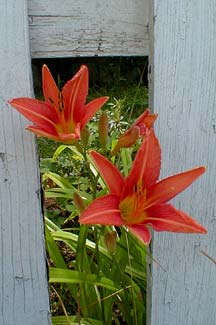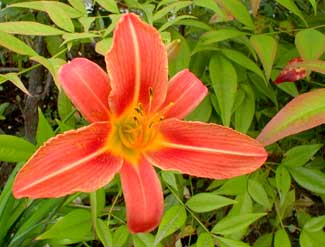
Orange Day Lily,
or Tawny Daylily
On a dry rocky slope, the Orange or Tawny Daylily (Hemerocallis fulva) has been naturalized for many years. Even though the area is also very shady, the daylilies managed most years to bloom at least a little. In time the roots were so thick & the wide clump so tired-out in that it bloomed with increasing feebleness.
I could not dig it up to divide the whole clump, because of the large rocks it had imbedded itself in, but I did manage to remove a sizeable chunk. Ideally one takes as much soil as possible, but the ideal was not possible here. I packed in some rich soil in the resulting hole, hoping that would revitalize the old clump, though it did not bloom the following year.
The new clump, however, which I planted by a picket fence, bloomed all fresh & happy in June 2002, as shown in the photo peeping through the pickets. It also spread like crazy & a year later had to be dug up again, & was put on the roadside where it can have all the room it wants.
The second photo from June 2004, after its spring transplanting. Daylilies bounce back to refreshed beauty more rapidly than do large irises which are even more likely to skip a seasoon of bloom after being seriously disturbed. A vigorous clump will probably need to be dug up & divided every four or five years.
 Though they do perform nicely in semi-shade, they will have more foliage than flowers; & though they also survive droughty conditions, flowers will be stuntier & fewer without regular watering. Daylilies cannot abide poorly draining soil & will rot under soggy conditions, but are otherwise impervious to just about everything.
Though they do perform nicely in semi-shade, they will have more foliage than flowers; & though they also survive droughty conditions, flowers will be stuntier & fewer without regular watering. Daylilies cannot abide poorly draining soil & will rot under soggy conditions, but are otherwise impervious to just about everything.Ideally they experience moist well-draining slightly acidic soil with sunlight all morning or all afternoon; if they get direct sunlight both morning & afternoon, the foliage can burn or wilt. When grown further south, they may need a higher percentage of filtered sunlight or bright shade.
They respond favorably to being fertilized, wanting more phosophorous & potash than nitrogen. A feeding at spring as new growth appears, & at midsummer, is the most that is necessary. Over-fertilizing is apt to be more harmful than not doing it at all.
A native of east Asia, Daylilies have naturalized in various parts of the world, including especially the eastern half of the United States, but also here in Washington state (but not further down the coast). Wherever they escape to the countryside, they like best sunny meadows & roadsides, but do not often penetrate woodlands. Although there are hundreds of named cultivars, it is usually this plain orange "Fulva" encountered in open fields, as the fancier daylilies are frequently sterile.
They are called Daylilies (or Day Lilies or Day-lilies) because when each bud opens, it expresses itself for one long sunny day, then is finished; hence the species name also means "One-Day-Beauty." However, it produces these flowers in succession for a minimum of one week, often for three weeks of June. There are varieties that will bloom earlier or later, but it is rare that any are flowering for longer than three weeks, unless one has chosen among the few specific cultivars known to be rebloomers, some of which will reflower from early June to August. We do also have one of these rebloomers, H. x hybrida "Ruby Stella."
For the majority, including our semi-wild one, each flower opens when morning light reaches it, & is spent as the sun goes down. But there are a few varieties that open in the evening & bloom through the night (H. citrina is night-blooming), besides some hybrids specially developed to bloom for sixteen hours, so that they are still in flower past sundown.
The flowers distinguish themselves from other lilies by facing upward & lacking spots. They come in a rainbow of colors, but orange is probably the most common & natural color.
The sword-grass varies in height from plant to plant, but ours prodcues grass less than two feet tall, & leafless scapes which uphold the flowers sometimes split into multiple stems, less than three feet tall. Various daylilies have grass that ranges from evergreen to to die-back; ours forms a pleasing clump spring through autumn but eventually turns yellow & begins to die back by mid-autumn.
Sometimes small plants will begin to grow along the flower scapes. These are called "proliferations." They can be removed & started as separate flowers. The more common methods of propogation, of course, are from seeds, or division. The most ornamental varieties are sterile triploids that can be propogated only by division or from proliferations.
In Asia, Daylilies are grown as a food crop, as the green flower buds can be taken to serve as though they were elongated fruits. Young leaf shoots are sweetish & make an excellent cooked vegetable standing in for asparagus. Mature spinachy leaves are a bit too fibrous, but have been used in soups & salads, either finely chopped or dried & powdered for later use. The spindly tubers along the fibrous white roots are a delicacy, doubling for chestnuts, & the larger roots themselves can be pealed to find a small edible portion at the heart. Even the seeds can be crushed & added to soups.
The mature flowers are typically allowed to have their "day" of beauty, then harvested as they wither, to be dried & crumbled for use as a soup thickener or flavoring. Freshly opened flowers can be eaten raw as a colorful crispy salad addition, the nectar in their throat having an especially fine taste. The nectar is rich in carbohydrates, the pollen high in protein, & the plant overall rich in vitamin A & iron.
They have never caught on as a food item in the west, where Daylilies are regarded exclusively as ornamentals. Some people even mistakenly believe the plant is toxic if eaten. They are indeed harmful to the kidneys of domestic cats, but there is no such effect on people, birds, dogs, livestock, or other animals. There exist reports that eating huge amounts of raw leaves can result in an hallucinogenic response, although no one has ever identified a specific hallucinogen, & the rumor seems to have as much truth to it as the idea that you can get stoned smoking banana peels.